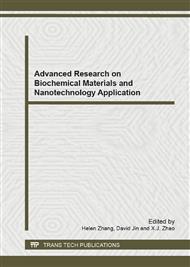[1]
C. Wang, P. Neogi, D. Forciniti, On one-dimensional self-assembly of surfactant-coated nanoparticles,J. Chem. Phys. 125 (2006) 194717.
DOI: 10.1063/1.2375091
Google Scholar
[2]
Wang, G.D. Liu, M.H. Engelhard, Y.H. Lin, Sensitive immunoassay of a biomarker tumor necrosis factor-α based on poly(guanine)-functionalized sil-ica nanoparticle label, Anal. Chem. 78 (2006) 6974.
DOI: 10.1021/ac060809f
Google Scholar
[3]
A.H. Yuwono, Y. Zhang, J. Wang, X.H. Zhang, H.M. Fan, W. Ji, Diblock copolymer templated nanohybird thin films of highly ordered TiO2 nanoparticle arrays in PMMA matrix, Chem. Mater. 18 (2006) 5876.
DOI: 10.1021/cm061495f
Google Scholar
[4]
P. B Dorn, C. Chou and J. Gentempo. J. Chemosphere. Vol. 16 (1987) 1501.
Google Scholar
[5]
J. Spivack, T.K. Leib and J.H. Lobos. J. Biol. Chem., Vol. 269 (1994) 7323.
Google Scholar
[6]
J. Hoigue and H. Bader. Water Res. Vol. 17 (1983) 173.
Google Scholar
[7]
J. Hoigue, H. Bader, W.R. Haag and J. Taehein. Water Res. Vol. 19 (1985) 993.
Google Scholar
[8]
M.R. Hoffmann, S.T. Martin, W. Choi and D.W. Bahnemann. Chem. ReV. Vol. 95 (1995) 69.
Google Scholar
[9]
A. Mills and S.L. Hunte. J. Photochem. Photobiol. A. Vol. 108 (1997) 1.
Google Scholar
[10]
P.D. Yang, D.Y. Zhao, D.I. Margolese, B.F. Chmelka, G.D. Stucky, Block copolymer templating syntheses of mesoporous metal oxides with large ordering lengths and semicrystalline framework, Chem. Mater. 11 (1999) 2813.
DOI: 10.1021/cm990185c
Google Scholar
[11]
Z. Sun, D.H. Kim, M. Wolkenhauer, G.G. Bumbu, W. Knoll, J.S. Gutmann, Syn-thesis and photoluminescence of titania nanoparticle arrays templated by block-copolymer thin films, ChemphysChem 7 (2006) 370.
DOI: 10.1002/cphc.200500340
Google Scholar
[12]
J. Gutierrez, A. Tercjak, I. Garcia, L. Peponi, I. Mondragon, Hybrid titanium dioxide/PS-b-PEO block copolymer nanocomposites based on sol-gel synthesis, Nanotechnology 19 (2008) 155607.
DOI: 10.1088/0957-4484/19/15/155607
Google Scholar
[13]
S. Forster, M. Antonietti, Amphiphilic block copolymers in structure-controlled nanomaterial hybrids, Adv. Mater 10 (1998) 195.
DOI: 10.1002/(sici)1521-4095(199802)10:3<195::aid-adma195>3.0.co;2-v
Google Scholar
[14]
Y.C. Chung and C.Y. Chen. Water Air Soil Pollut. Vol. 200 (2009) 191.
Google Scholar
[15]
J.G. Yu, H.G. Yu and B. Cheng. Acta Chimica Sinica. Vol. 61 (2003) 1271.
Google Scholar
[16]
R.H. Davis and D. Worsley. Chem. Soc. Rev. Vol. 22 (1993) 417.
Google Scholar
[17]
S. Kaneco, H. Katsumata and T. Suzuki. J. Chem. Eng. Vol. 125 (2006) 59.
Google Scholar
[18]
Y.Q. Hou, D.M. Zhuang and G. Zhang. Chinese Journal of Catalysis. Vol. 25 (2004) 96.
Google Scholar
[19]
J.M. Wu and T.W. Zhang. J. Photochem. Photobiol. A. Chem. 162 (2004) 171.
Google Scholar


